Soviet Architecture in Tbilisi: My 15 Favourite Buildings, Interiors & Mosaics (With a Map)
16 min readTbilisi is a wild kaleidoscope of architectural styles and buildings from different epochs. Some of the most striking landmarks date to the Soviet era, 70 years of history that left a lasting imprint on the city skyline.
Examples of Modernism, Brutalism, Constructivism and Stalinist architecture can all be found in Tbilisi. This includes apartment blocks, university buildings, libraries and government offices, plus war memorials, monuments, bas-reliefs and decorative mosaics.
If you’re a fan of this genre of architecture, of street photography and/or urbexing, then you will love exploring Tbilisi’s Soviet leftovers.
This guide is a shortlist of what I believe to be the most interesting examples of Soviet architecture and interiors in Tbilisi. More than just buildings to snap a photo of, they are all sites you can ‘interact’ with. Some are still being used for their intended purpose, others have been refurbished or reinvented, and a few are abandoned.
I firmly believe that these monuments, mosaics and monolithic buildings are a valuable part of the city’s built environment and should be protected. Each one is an ambitious work of art and an example of skilled design. If nothing else, they offer a precious glimpse into the period when they were built and an inroads to important discussions about life and politics in modern-day Georgia.
If you’re into mosaics and urbex, be sure to check out my new guide to The Monument Route in Western Georgia.
Note: I was invited to visit several of these locations on a Brutal Tbilisi Urban Exploration tour with Friendly.ge. All opinions and recommendations are 100% my own.
Please note: This post contains affiliate links, meaning I may earn a commission if you make a purchase by clicking a link (at no extra cost to you). Learn more.
Discover Tbilisi’s Soviet architecture on a tour
While all of these sites can quite easily be visited independently, they are spread out across the city and a couple (especially #3) are a bit tricky to find.
If you want a more in-depth experience, consider joining an architecture-themed tour of Tbilisi. I highly recommend the Brutal Tbilisi Urban Exploration Tour with Friendly.ge. It includes half a dozen of the spots on this list (plus a couple more I haven’t covered), with transportation by car and a private guide.

Friendly brings a sensitive and respectful approach to this topic. They use every landmark as a learning moment to expand your knowledge about Georgia’s past, present and future. They know all the best spots and will introduce you to the people behind the scenes – such as Mzia, Matron of the Elevators whom I talk about in my post about the Tbilisi Skybridge.
Book the tour on the Friendly.ge website and use the promo code WANDERLUSH to get 10% off.
If you are exploring alone, always use caution and common sense when visiting remote sites. I do not recommend trespassing on private property. Take care not to be too intrusive in residential areas.
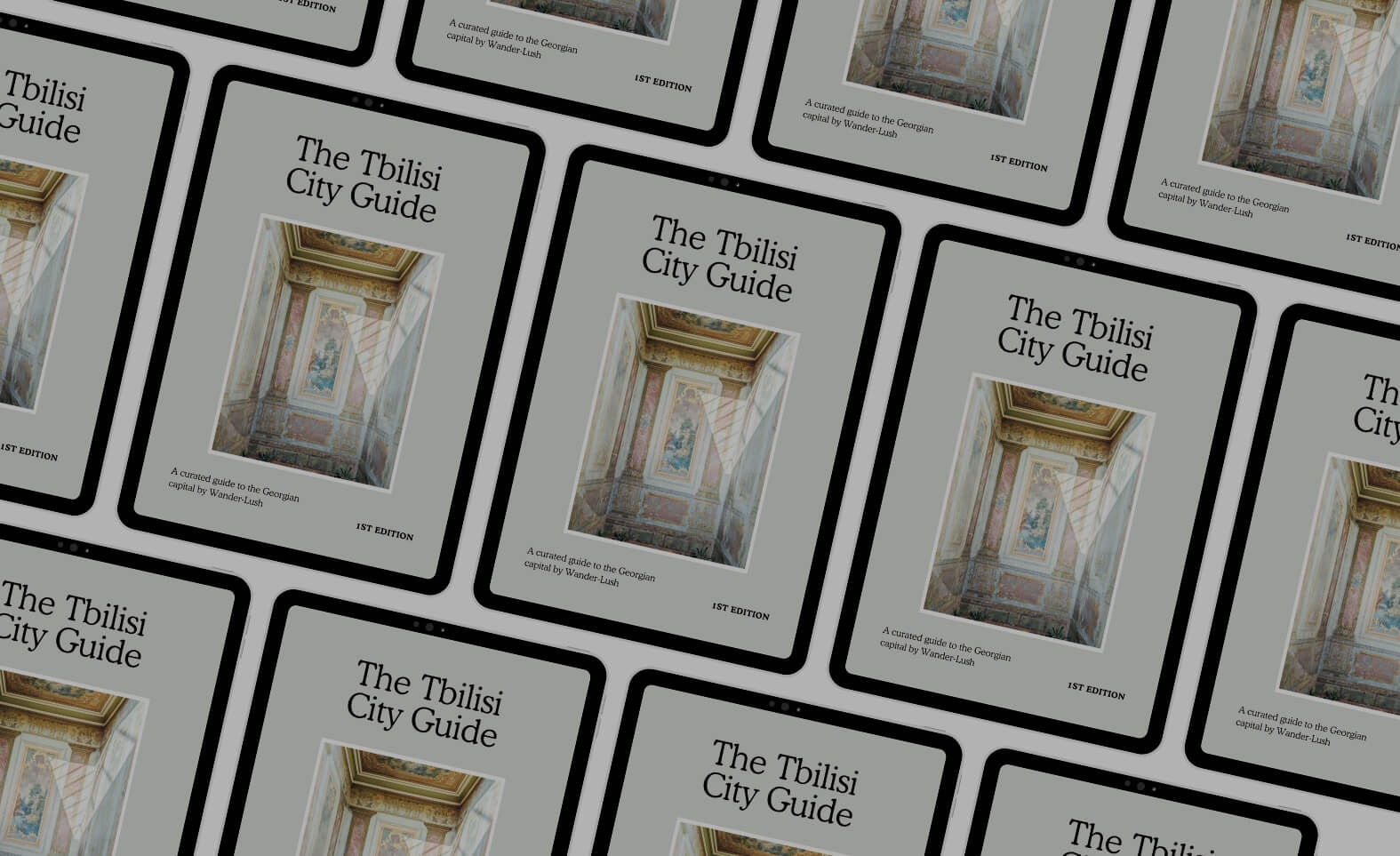
Looking for more expert Tbilisi travel tips?
My new ebook The Tbilisi City Guide is a detailed handbook for Tbilisi, with 7 guides & 20 maps for different neighbourhoods. Get your copy here via Payhip.
15 must-see examples of Soviet architecture in Tbilisi
1. The Former Palace of Rituals (Arcadia)

The Former Palace of Rituals or Wedding Palace is an icon and probably the best example of Postmodern Soviet architecture in Tbilisi.
Completed in 1984, it was designed by Georgian architect Victor Djorbenadze, who has been referred to as ‘the Georgian Le Corbusier’. Another one of his buildings is #7 on this list.
When it first opened, the Palace of Rituals primarily functioned as an all-in-one wedding venue, with restaurants, a dress and suit rental business, and even couples counselling. Other events were held here too, including children’s shows to celebrate the New Year and events for the Young Pioneers.
Part of the Soviet policy was to erase religion from people’s minds, but Djorbenadze managed to weave many ecclesiastical elements into his design for the Palace. The facade resembles a cathedral, and the main hall is decorated with icon-like frescoes.
The architect’s design was famously defended by Eduard Shevardnadze, First Secretary of the Georgian Communist Party, who encouraged his colleagues to tolerate a bit of church-like symbolism because it ‘made the people happy’.


The exterior of the Palace is faced with limestone from Kutaisi to give it a warmer feel (Djorbenadze was not a fan of cold concrete). The double round towers – one for the groom and the other for the bride – with the central ‘bell tower’ also has anatomical undertones. When viewed from above, the layout of the building clearly represents the female reproductive system – apparently Djorbenadze was inspired by sketches made by his mother, who was a physician.
Everything here represents the union of man and woman. The statue at the main entrance depicts Hermaphroditus, the two-sexed child of Aphrodite and Hermes.

The Palace of Rituals stopped functioning in the 90s and in 2002, it was bought by a private investor who recently rebranded the complex ‘Arcadia’. Most of the rooms have been transformed from offices and meeting halls into lounges and bars, each with a different theme: The Egyptian Room, the Chinese Room, the Louis XVI Room, etc. The decor is next-level decadent.
The main hall where couples would sign their papers in the past has been somewhat preserved. It features an incredible pyramid roof in the Darbazuli Sakhi Meskhetian style (you can see examples of this traditional architecture in villages around Akhaltsikhe in Southern Georgia).

Above the ceremonial altar, the murals are reminiscent of Orthodox frescoes but incorporate astrological symbols instead of religious imagery. The main image is clearly a depiction of Tbilisi city, with several landmarks including Dinamo Stadium visible.
Where there would normally be a depiction of the church’s founding father, there is an image of the architect with the head of a lion and a technicolour mane holding out a miniature version of the building.


After being closed for more than 20 years, the Palace recently reopened to groups. In winter 2023, I was lucky enough to be part of the first ever English-language tour. In 2024, I joined another tour – I can’t get enough of this building!
Friendly.ge now organises visits to the Palace every spring, plus on demand – book a tour here via Get Your Guide. If you are unable to join a tour, you can view the exterior of the Palace from the nearby Aragveli Bridge.
Location: Bochorma Street | 41.685434, 44.826749
2. The Tbilisi Skybridge (Nutsubidze Skybridge)
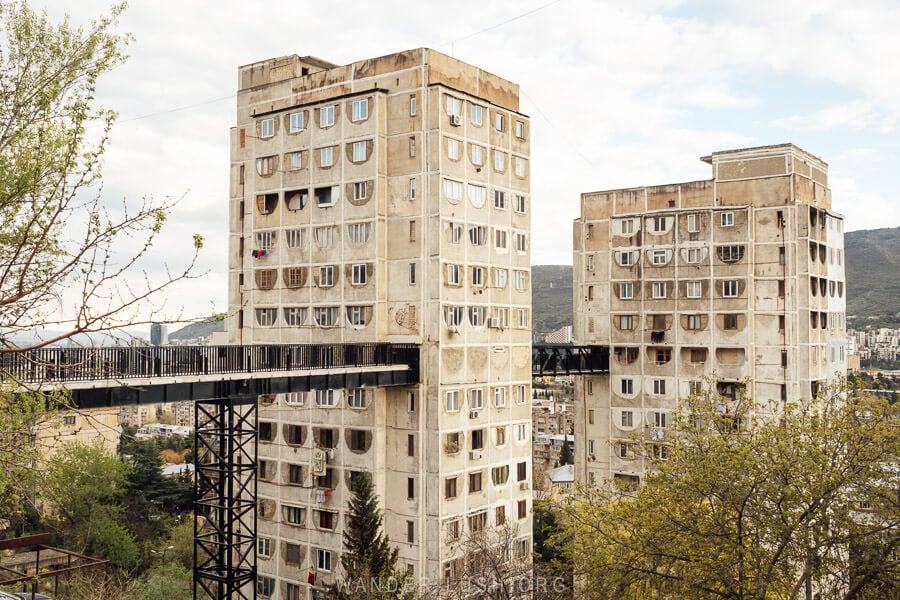
The Nutsubidze Skybridge is an experimental Soviet-era housing complex in Saburtalo district. It consists of three high-rise concrete apartment blocks arranged over a steep hillside, linked together by elevated concrete bridges.
Constructed in 1974-76 according to the designs of architects Otar Kalandarishvili and Gizo Potskhishvili, this complex was certainly cutting-edge at the time. The original plan was to craft an entire community of skyscrapers and skybridges, but due to a lack of funds only a small part of the project was realised.


Anyone can visit the Skybridge and use the public elevator to access the caged walkways. Remember to bring the exact change with you – the fare is 20 tetri per person per ride, and the machine inside the lift only accepts 20 tetri coins.
Learn more about the building’s history and read my tips for visiting in this dedicated Tbilisi Skybridge guide.
Location: S. Nutsubidze Street
3. The Former Archaeology Museum & Telatgori Water Reservoirs

Completed in 1988 by architects Shota Kavlashvili and Shota Bostanashvili, this zoomorphic building almost looks like a lion crouched on the hillside, ready to pounce on cars travelling down the highway. The relief above the main entrance depicts a human form in the foetal position, a reference to traditional Colchian burial rites.
The building was only used for a short period before it was closed and its collections relocated to other museums in Tbilisi. You cannot enter inside the main building, but you can explore the surrounding area.
Nearby the museum there is a Brutalist monument of Saint Nino, one of Georgia’s patron saints.

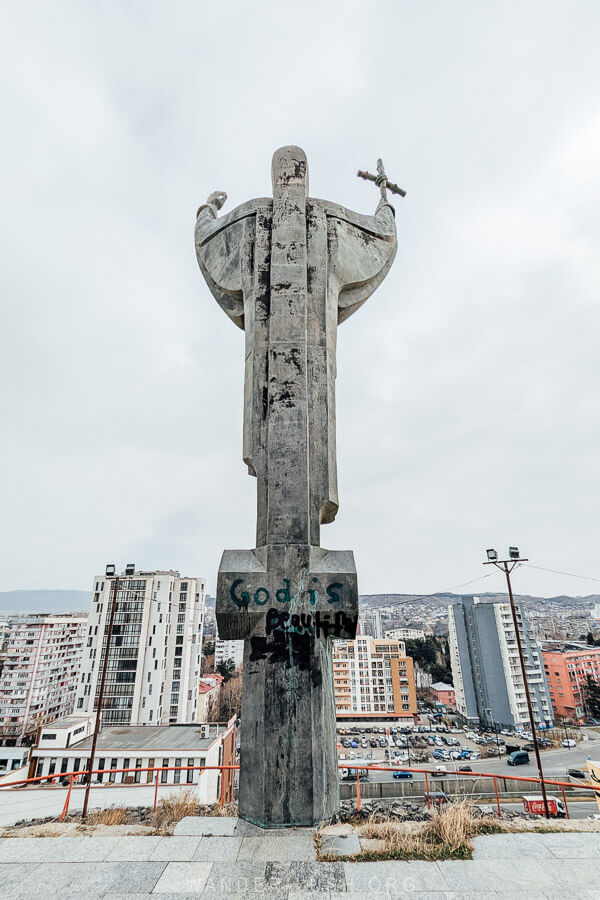
On the same territory, three underground water reservoirs were created to alleviate Tbilisi’s issues with drinking water before they were decommissioned and drained.
Plans to retrofit them as subterranean exhibition spaces for the Archaeology Museum were abandoned (inside one of the reservoirs, you can see concentric brick walls were built) and the structures lay dormant.

The big reservoir is the most impressive. You can reach it via a perilous ladder that emerges from the earthen mound behind the museum building. The acoustics inside are incredible – choral groups sometimes rehearse and perform here.
Important update: In early 2025, signage was installed to prohibit people from entering the area where the water reservoirs are located. The site may not be accessible, and it is no longer included on the Brutal Tbilisi Urban Exploration tour.
Location: G. Brtskinvale II Turn
4. Former Ministry of Highways Building

Now the Bank of Georgia headquarters, this iconic 18-storey building with interlocking concrete ‘arms’ resembles a teetering Jenga tower or a 3D hashtag (the design was a space-saver and allowed ‘nature to flow through’).
It was built in 1976 on the designs of Georgian architects Zurab Jalaghania and Giorgi Chakhava – the latter was also the Minister of Highways at the time.
View it from the opposite bank of the river, or venture into the car park for an up-close look. Inside the new glass cube building there is a small exhibition of photos, blueprints and renders related to the building’s construction. If the security guard is in an amicable mood he might let you into the lobby for a look!
Location: 29a I. Gagarini Street
5. Vera Technical Library
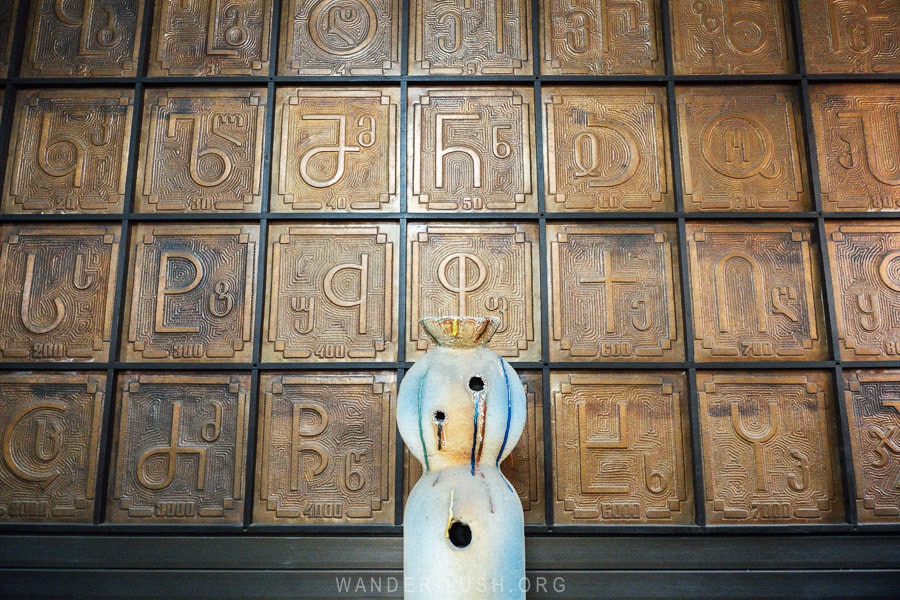
Officially the National Scientific Library, this modernist masterpiece is instantly recognisable for its sail-shaped brise soleils. Round portals at either end add to the feeling that this building is a ship lost in the night.
Designed in 1985 by the architect Gari Bichiashvili, it currently houses a casino and various businesses.


One floor still functions as a working library, with original Soviet-style relief sculptures, a tapestry wallhanging, and other decorations preserved in situ by the friendly team of librarians.
Location: 45/57 M. Kostava Street
6. Former Trade Union Palace of Culture


This block-wide Brutalist building sits above the entrance to the Delisi Metro Station – yet because of the permanent construction fencing that disguises the facade, most people walk right past it.
Built in 1968-70 by a trio of Georgian architects, the former Trade Union Palace of Culture was decorated by Zurab Tsereteli of Chronicles of Georgia fame (see below). The wrap-around mosaic on the exterior is quirky to say the least. Titled The Human Being, The Work – Purpose and Beauty of Existence, it depicts a pair of pregnant rabbits worshipping the sun.
The building still functions as an events space. There are several small book shops on the lower levels, thus you can walk inside and pass through unlocked doors without any resistance. (For the best chance of getting inside, visit on a Saturday or Sunday morning.)
The stairwell and wall with bulls and other figures punched out and filled with coloured glass is absolutely spectacular in the right light. On the opposite wall, the same shapes are mirrored in concrete.
The Centre is scheduled to be demolished to make way for yet another high-rise – let’s hope the developers make good on their promise to preserve the mosaic and glassworks.
Location: 43 Vazha-Pshavela Avenue
7. Wedding Hall No. 1


Though it doesn’t exactly fit with the ‘Brutal’ theme, Wedding Hall No. 1 is very interesting to visit because it is an example of a Soviet-era building located in the heart of Old Tbilisi.
Similar to the Palace of Rituals, this building also served as a place for couples to officiate their marriages. The typical Old Tbilisi house, complete with a pretty wooden balcony, predates the Soviet era, but the decorations inside are quite typical of the day.
This venue was quite prestigeous: I’m told that after a ceremony here, couples could request to be paraded around Old Tbilisi in a horse-drawn carriage. It is still an active registry office, and you will often find the door is open.
Wedding House N2 on the riverside in Chugureti also has some very interesting (less delicate, more Brutal!) sculptures on the facade and in the entryway.
Location: 28/21 Chakhrukhadze Street
8. Maglivi-Bagebi Ropeway & Former Baghebi Student Dormitories

This lesser-known cablecar connects the Ivane Javakhishvili Tbilisi State University (TSU) campus in Saburtalo with a set of student dormitory buildings in Bagebi on the opposite side of the Vera River Gorge.
The cableway was strung in 1983 and operated for a few short years before falling into disrepair and finally closing in 2004. In April 2021, the line relaunched – still with its retro blue box-shaped gondolas – and is once again ferrying students, commuters and students alike across the gorge at a height of 320 metres.
The student dorm buildings themselves – two tall, slender concrete structures with a cubic surface pattern of protruding balconies – are quite interesting to see up-close. Among the residents there are some internally displaced families from Abkhazia.

The former dorms are like their own small community, with a chapel erected in the liftwell and graffiti on the stairs advertising different businesses and services.
The lower cable car station is located on University Street, a short uphill walk from the final metro station on the Saburtalo line. It costs 1 GEL to ride and you can use your regular MetroMoney card to tap on.
Location: Tskneti Highway
9. The Chronicles of Georgia
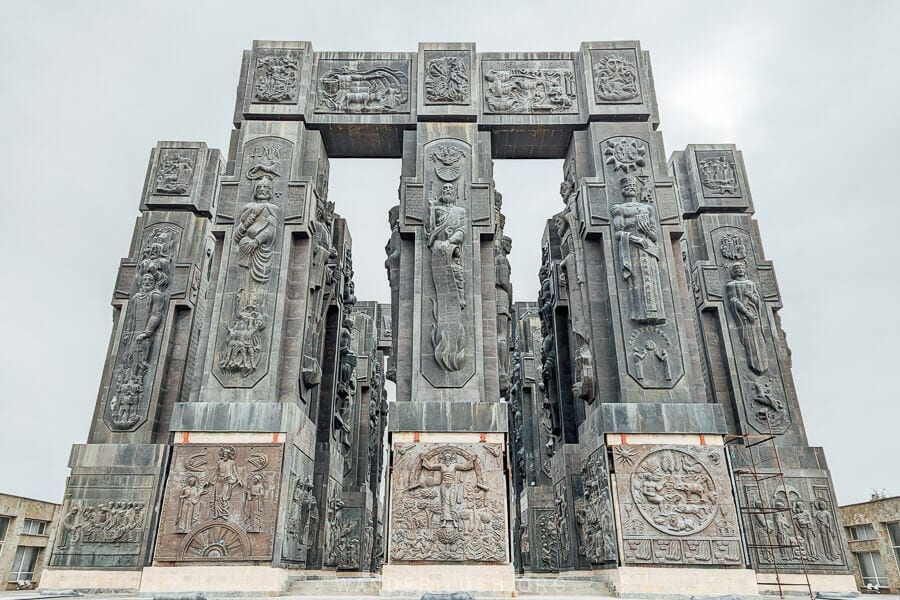
Perched on Keeni Hill above the Tbilisi Sea, the Chronicles of Georgia is a massive sculptural ensemble created by the late Zurab Tsereteli. Work on the monolith (initially a 100-metre-tall Stalin was planned for the location, but that was overruled) started in 1985 to commemorate 3,000 years of Georgian statehood and 2,000 years of Christianity. Waning funds meant that it was never fully completed, and scaffolding has always been a common sight here.
Two Greek-style columns mark the main entrance: A cascading concrete staircase. At the top, the main sculpture consists of 16 pillars (arranged in the shape of a cross) that reach 35 metres high. Each one is wrapped in bronze and copper reliefs. There are three horizontal ‘layers’, a triptych that you can read from left to right, with each strata telling a different story.
On the bottom there are recognisable Biblical scenes; the tall middle band depicts important figures from Georgian history (monarchs, diplomats, poets and writers); and a third level on the outer columns reveals important national traditions such as the Rtveli wine vintage.


The interior of the small stone chapel, the Annunciation Church, is completely covered in iconographic panels crafted at the same workshops – they are not painted, but rather they are made from cloisonne enamel.
Panoramic views of the reservoir and Gldani district (a sea of uniform ‘Khrushchyovka’ apartment blocks) are another highlight. Visit in the late afternoon for the best light (the monument faces west) or after dark to see the friezes illuminated.
Location: Utsnob Gmirta Street
10. The Arashenda Building

Literally the building that ‘did not get built’, this 17-storey block by architects Dimitri Tumanishvili and Temur Tkhilava was started in 1982, but never completed. The design – with two towering wings bent slightly inwards – is meant to resemble an open book.
The building was supposed to become the Hotel Odishi, but it was abandoned mid-way through construction and became apartments instead. Climb one of the external stairways for a stellar view of the Chronicles of Georgia monument.
Location: Anapa 414-th Division Street
11. Mukhatgverdi Cemetery

The Brothers’ Mukhatgverdi Cemetery is a military cemetery on the outskirts of Tbilisi, close to Mtskheta. In 1972-4 Victor Djorbenadze (who would go on to design the Palace of Rituals) was invited to build a complex of halls and buildings here.
Despite being commonly referred to as a crematorium, it was never used for cremations (such practices are definitely not part of Georgia’s Orthodox tradition). Instead, the unusual building with twin towers was used as a ceremonial hall for mourners.


The hall and three more Djorbenadze buildings (an office, a water tower and a workshop) are abandoned and derelict, but easy to access. The architect is said to be buried here at Mukhatgverdi, too.
Location: Mukhatgverdi Street
12. The Lotkin Monument

This curled concrete column was conceived to commemorate the 800th anniversary of the birth of Georgia’s national poet, Shota Rustaveli, in 1973 – the year officially designated the Rustaveli Jubilee.
After a temporary ban on monuments stalled construction, architects Nodar Jobadze and Alexander Bakradze broke ground in the 1980s.


The spire would have been twice as tall – and it would have included a centre for arts and culture – but the project was abandoned, leaving only the 40-metre-high concrete base behind. Rock climbers have since added artifical holds, hence its alternative name and function: Urban Climbing Monument.
Location: Khudadovi Street
13. Former Gogilo Bathhouse

Abanotubani is famous for its sulfur baths, but the natural springs extend to Avlabari district too. The former Gogilo Abano bathhouse functioned until the 1970s when the Mtkvari River was diverted, stifling the font that once fed it.



The main building is abandoned and derelict, but four glorious mosaic domes by artist Kukuri Tsereteli have survived. You can look down at them from the side of the highway or venture along the stone path near the petrol station for a closer look.
Location: Off K. Dedofali Avenue
14. Expo Georgia

Exposition Georgia (formerly the Exhibition of Achievements of National Economy or VDNKh) is a Soviet-era complex of halls and pavilions purpose-built to host Tbilisi’s trade fairs in 1971. Similar centres were also established in Moscow, Kyiv, Minsk and Yerevan.
Today Expo Georgia hosts various festivals and events, including the annual Tbilisi International Book Festival and WinExpo wine fest.
The grounds are open to the public and feature walking paths, artificial ponds, gardens and a cafe alongside fascinating Modernist buildings, mosaics and sculptures flanked by tall palm trees.
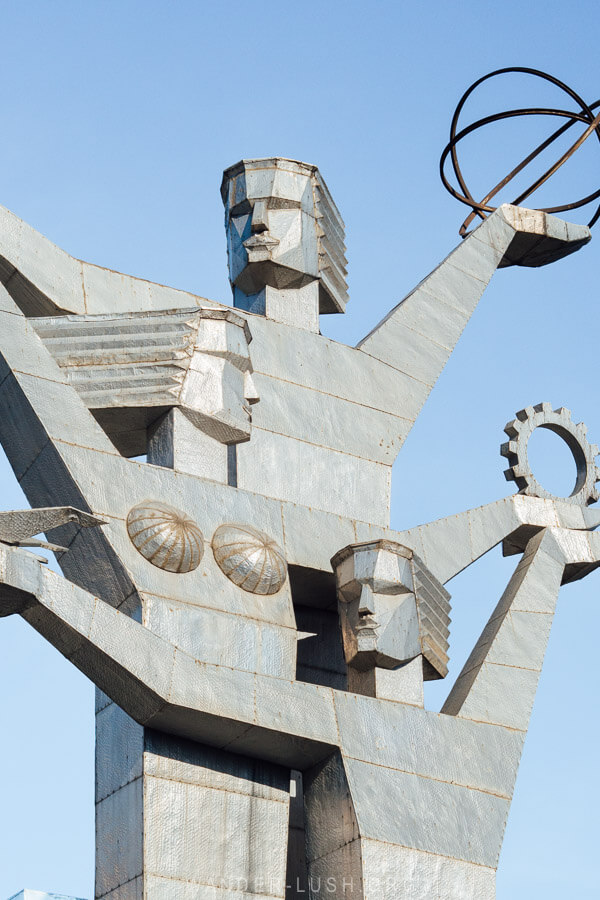

A full-wall mosaic close to the entrance shows cosmonauts and scientists. Designed by Leonardo Shengelia in 1963, it is in impeccable condition. Adjacent, the ‘Monument to Creativity’ depicts a man, woman and child holding symbols of science and industry on outstretched palms.
Location: 118 A. Tsereteli Avenue
15. The Tbilisi Metro

The Tbilisi metro system is probably the city’s best-known (and most useful) leftover from the Soviet period. It was constructed over a decade-long period starting in 1952, when the city’s population was still shy of the one-million-person threshold required to justify a rapid transit system.
The first six-station line was inaugurated in January 1966, making it the fourth underground in the former USSR (after Moscow, Saint Petersburg and Kyiv), and the first in the South Caucasus region. After a series of expansions, it now covers 26.4 kilometres of track and 23 stations.
Apparently the original project design dictated that the platforms should be richly decorated in the image of the Moscow Metro. In the end, though, most stations turned out to be very austere due to time and budget constraints. You can find some very nice flourishes here and there, including brass reliefs and a few mosaics.

For just 1 GEL you can go on a self-guided tour of the Tbilisi Metro, stopping to admire the more interesting platforms.
Noteworthy stations include the mosaic-clad Technical University M/S, Rustaveli M/S (the deepest station in Tbilisi, with a 120-metre-long escalator), Isani M/S (with a stunning mosaic of King Vakhtang, the founder of Tbilisi, with his pheasant), Ghrmaghele M/S (with a sculpture inspired by the nearby railway works), and 300 Aragveli M/S (featuring a bas-relief of the canonised martyr-soldiers who died defending Tbilisi against the Qajar army in 1795).

Photography is not technically allowed inside the underground stations, which are still classified as ‘objects of strategic importance’ – so you might get reprimanded by the patrolling security guard if you whip out your phone!
Bonus: other various mosaics in Tbilisi

Other notable Soviet-era mosaics in Tbilisi include the ‘secret’ VIP room at the No 5 Sulfur Bathhouse in Abanotubani; the Former Ministry of Forestry Laboratory building, with its 1987 vertical Tree of Life panel by the artists Zurab Kharabadze, Murman Mikaberidze and Badri Dolidze (pictured below); and the mosaic fragment pictured above (author and date unknown), which depicts cosmonauts and once decorated a textile factory in Isani.


Located on the Emergency Management Service building in Ortachala, the iconic Fire in His Hands mosaic (pictured above) was completed 1979 by the artist Givi Kervalishvili, and shows all the major achievements of Soviet-era construction in Tbilisi – from Dinamo Stadium to the Academy of Sciences. On the facade of the nearby Central Bus Station, there is a mechanical-themed mosaic by Zurab Tsereteli.
For more mosaics in Tbilisi, see this wonderful map curated by GeoAir.
Map of Soviet-era landmarks in Tbilisi
Click to open & save in Google Maps.

More ideas for Tbilisi & Georgia
- How to visit the Chronicles of Georgia, with insider tips
- Guide to visiting Tskaltubo, a semi-abandoned spa town from the Soviet era
- Guide to visiting Zestafoni, an industrial city in Western Georgia
- Inside the Zestafoni Ferroalloy Plant, a relic of Georgia’s Soviet past
- Visiting Chiatura, the mining city with cable cars
- Things to do in Gori, including the Soviet Gori Tour
- Visiting Stalin’s Underground Printing House in Tbilisi, a museum like no other!
- How to visit the Tbilisi Skybridge, a Brutalist icon in Tbilisi
- Travelling the Soviet-era tea route in Guria, Western Georgia
- Soviet-era mosaics & sanatoriums in Kobuleti, a resort on the Black Sea Coast
- Visiting the UAZ ambulance graveyard in Zugdidi, vintage Soviet cars



